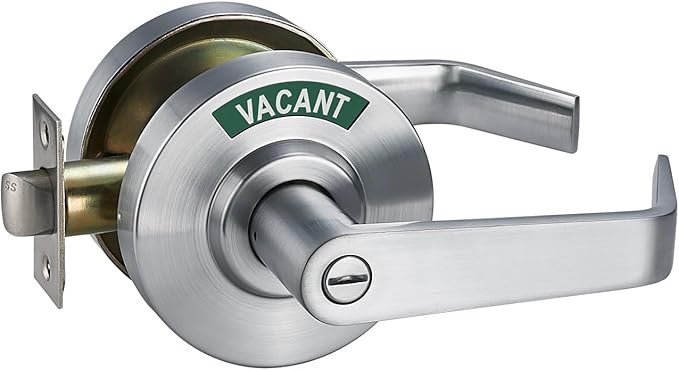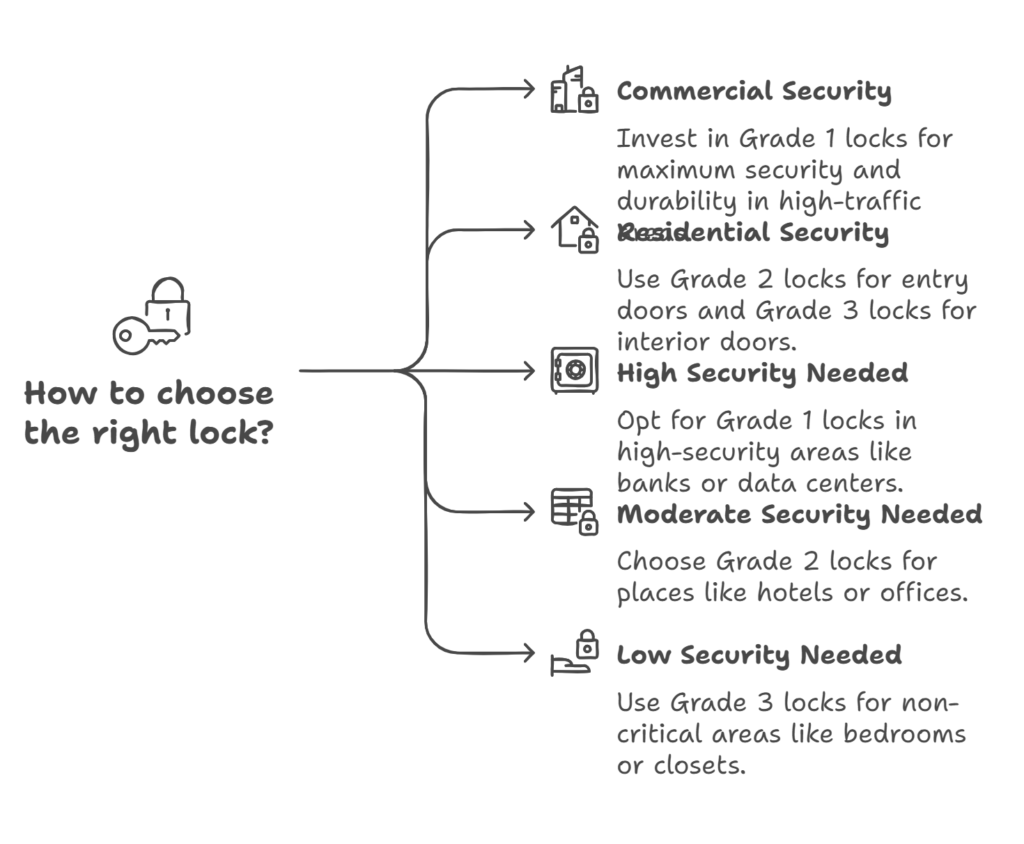
What Are ANSI Grades of Door Locks?
Introduction
When selecting a door lock for your home or business, security and durability are top priorities. But how can you determine which lock is best suited for your needs? In the United States, door locks are graded based on performance standards set by the American National Standards Institute (ANSI) in collaboration with the Builders Hardware Manufacturers Association (BHMA). These organizations establish rigorous testing criteria to ensure that locks meet specific security, strength, and longevity requirements.
Why Understanding ANSI/BHMA Lock Grades Matters
ANSI/BHMA lock grades help consumers and professionals make informed decisions when choosing door locks. Whether you’re securing a commercial building, a residential property, or an interior space, knowing the differences between Grade 1, Grade 2, and Grade 3 locks allows you to select the most appropriate option for your security needs.

What This Blog Covers
In this blog, we will break down:
How the ANSI grading system works and why it is important.
The three ANSI lock grades (Grade 1, Grade 2, and Grade 3)—their security levels, durability, and typical applications.
How to choose the right lock based on your specific security requirements.
By the end of this guide, you’ll have a clear understanding of ANSI lock grades and be able to make a well-informed choice when selecting door locks for your home or business.
Understanding ANSI/BHMA Lock Grades
The Role of ANSI and BHMA in Lock Grading
In the United States, door locks are rigorously tested and classified based on performance standards established by the American National Standards Institute (ANSI) and the Builders Hardware Manufacturers Association (BHMA). ANSI is a private, non-profit organization that oversees voluntary standards across various industries, while BHMA is the trade association responsible for developing and maintaining performance and safety standards for builders’ hardware, including locks.
Locks that meet ANSI/BHMA certification must pass a series of mechanical and security tests that evaluate strength, durability, and overall performance. This grading system helps manufacturers produce high-quality locks while giving consumers and businesses a standardized way to compare security levels.
Why Lock Grading Matters
Understanding ANSI lock grades is essential for homeowners, property managers, and business owners because:
It ensures the right level of security—whether for a home’s front door or a high-traffic commercial facility.
It helps consumers make informed purchases, avoiding overspending on security they may not need or underestimating their security requirements.
It improves long-term durability and reliability, as locks with higher grades are built to withstand frequent use and physical force.
Breakdown of ANSI Lock Grades
Grade 1 – Highest Security
Overview:
Grade 1 locks provide the highest level of security and durability, making them ideal for commercial and high-security applications. They undergo the most stringent testing to ensure long-term performance under extreme conditions.
Key Performance Requirements:
Withstand 800,000 cycles of operation.
Endure 6 door strikes with a hammer.
Support a 360-pound weight test without failure.
Common Uses:
Government buildings.
Airports.
Heavy-duty commercial doors.
High-security residential properties.
Grade 2 – Medium Security
Overview:
Grade 2 locks offer a balance between security and affordability, making them suitable for residential entry doors and light commercial use. They are more durable than Grade 3 locks but not as robust as Grade 1.
Key Performance Requirements:
Withstand 400,000 cycles of operation.
Endure 4 door strikes with a hammer.
Support a 250-pound weight test without failure.
Common Uses:
Office buildings.
Hotels and hospitality spaces.
Storage rooms.
Residential front and back doors.
Grade 3 – Basic Security
Overview:
Grade 3 locks provide the lowest level of security and are primarily used for interior doors or residential entry doors in low-risk environments. While they meet minimum security standards, they are not recommended for high-security applications.
Key Performance Requirements:
Withstand 200,000 cycles of operation.
Endure 2 door strikes with a hammer.
Support a 150-pound weight test without failure.
Common Uses:
Interior doors in homes.
Low-risk residential entry doors.
Areas where minimal security is required.
Why ANSI Lock Grades Matter
Helping Consumers Make Informed Decisions
ANSI lock grades provide a clear, standardized benchmark for consumers to compare different locks based on security and durability. Without these ratings, buyers would have to rely solely on marketing claims, which may not always reflect a lock’s true performance. By understanding these grades, homeowners, businesses, and property managers can select the most appropriate lock for their specific needs.
Ensuring Compliance with Building Codes
In commercial and multi-family residential buildings, local and national building codes often require door hardware to meet specific ANSI/BHMA standards. Using the correct lock grade ensures compliance with these regulations, avoiding potential fines or legal issues.
For example, Grade 1 locks are frequently required for fire-rated doors, emergency exits, and commercial entry points, where security and durability are paramount. Residential buildings may also have minimum security standards, particularly for rental properties and multi-unit housing.
Impact on Insurance Requirements and Security Standards
Many home and business insurance policies consider lock security when determining coverage and premiums. Some insurers may require ANSI-certified locks on entry doors, particularly in commercial settings, to qualify for lower rates or even coverage eligibility.
A higher-grade lock can:
Reduce the risk of break-ins, potentially lowering insurance premiums.
Demonstrate due diligence in securing a property, which can be beneficial in liability claims.
Enhance overall security, giving property owners peace of mind.

Choosing the Right Lock for Your Needs
Selecting the right lock depends on several factors, including location, security needs, and budget. Here’s a breakdown of key considerations:
1. Location: Residential vs. Commercial
Commercial properties should invest in Grade 1 locks for entry doors, storage rooms, and high-traffic areas to ensure maximum security and durability.
Residential properties can benefit from Grade 2 locks for entry doors and Grade 3 locks for interior doors.
2. Level of Security Required
High-security areas (banks, data centers, government buildings) require Grade 1 locks.
Moderate security areas (hotels, offices, rental properties) should use Grade 2 locks.
Low-security areas (bedrooms, closets, non-critical rooms) can use Grade 3 locks.
3. Budget Constraints
Higher-grade locks cost more but offer greater durability and security.
If cost is a concern, consider using Grade 1 locks on main entry points and Grade 2 or 3 locks for secondary or interior doors.
Recommendations for Different Use Cases
Use Case | Recommended Lock Grade |
Front Door (Home) | Grade 2 |
Apartment/Rental Entry | Grade 2 |
Interior Home Doors | Grade 3 |
Office Building Main Entry | Grade 1 |
Hotel Room Door | Grade 2 |
Warehouse or Storage Room | Grade 1 |
High-Security Facility | Grade 1 |
Conclusion
Key Takeaways
ANSI/BHMA lock grades provide an essential standard for assessing lock security and durability.
Grade 1 locks offer maximum security, suitable for commercial and high-risk environments.
Grade 2 locks balance security and cost-effectiveness, making them ideal for most residential and light commercial applications.
Grade 3 locks are best for interior residential use or low-risk areas.
Understanding lock grades helps with compliance, insurance benefits, and overall security planning.
Final Thoughts
Choosing the right lock is a crucial decision that impacts both security and convenience. By understanding ANSI lock grades, homeowners and businesses can make informed choices, ensuring they invest in locks that provide the best balance of security, durability, and affordability. Whether securing a home, office, or commercial building, selecting the appropriate lock grade is a simple yet effective step in enhancing safety and peace of mind.
Citations: [1] https://www.thisoldhouse.com/home-safety/21015270/how-to-pick-a-lock [2] https://www.cytlocks.com/what-are-ansi-door-lock-grades-ansi-grades-1-3-explained/ [3] https://www.pdqlocks.com/blog/a-guide-to-ansi-grade-1-vs.-grade-2-door-hardware [4] https://www.parkavenuelocks.com/lock-grades-explained [5] https://www.thisoldhouse.com/home-safety/118041/lock-grades [6] https://www.acmelocksmith.com/articles/ansi-lock-grades-explained/ [7] https://ca.weiserlock.com/blogs/posts/how-is-door-hardware-graded [8] https://www.clksupplies.com/blogs/news/locksmithing-101-lock-hardware-grades-1-2-and-3 [9] https://www.hoppe.com/in-en/contacts-service/standards/bs-en-12209/
